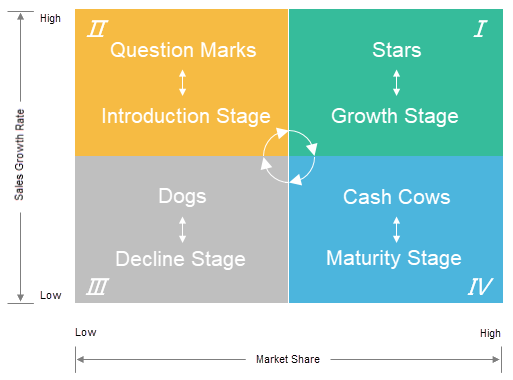Overview
Definition
Boston Consulting Group Matrix (BCG Matrix) is also known as the growth-share matrix, Boston Consulting Group analysis, portfolio diagram, and product portfolio matrix.
BCG matrix classifies products into four categories, as shown in the following figure.

Application
The matrix analyzes and determines a company's product portfolio structure based on the sales growth rate (reflecting market attractiveness) and the market share (reflecting company strength).
Expected Effect

Implementation Ideas
By setting cordons, you can divide the area into four quadrants to observe data.
You can continue to set drill-down directories to observe data of higher granularity.
Procedure
You can use the FineBI built-in RFM analysis table detailed data as the sample data.
Creating a Component
1. Create an analysis subject, enter RFM analysis table detailed data in the search field, select the data, and click OK, as shown in the following figure.

2. Click the component tab in the bottom left corner, as shown in the following figure.

Adding a Calculation Indicator
1. Add a calculation field named Average Order Value, with the formula set to: SUM_AGG(MONEY)/COUNT_AGG(CUSTOMERNAME).

Creating a BCG Matrix with a Scatter Chart
1. Observe the given data, where the customers in the system have names and corresponding types. This structure is called a tree structure, which often appears in a company's organizational hierarchy. You can set normal data drilling for detailed data viewing. In this example, the tree structure is relatively simple, with only two levels: customer type and customer name.
To reflect this hierarchical relationship in a Boston matrix chart, you need to create a drill-down directory (dragging the field CUSTOMERNAME into CUSTOMERTYPE), as shown in the following figure.

2. Set Chart Type to Scatter Chart, drag the field Count into Vertical Axis, drag the calculated indicator field Average Order Value into Horizontal Axis, and drag the drill-down directory into Graphic Property > Fine-grained, as shown in the following figure.

3. Click the ![]() icon next to the field Average Order Value and choose Set Analysis Line > Cordon to add two cordons, as shown in the following figure.
icon next to the field Average Order Value and choose Set Analysis Line > Cordon to add two cordons, as shown in the following figure.

4. Click Add Cordon, name the cordon Average Spending Amount, set the formula to AVERAGE(Average Order Value), and click OK (You can set the cordon color.), as shown in the following figure.

Similarly, add a cordon named Average Number of Spending, as shown in the following figure.

Effect Display
For details, see section "Expected Effect."
Conclusion
Based on the scatter chart, a rough analysis of the customer profile of this company can be outlined.
Customers whose number and amount of spending exceed the average level are classified as star customers. These customers need to be paid great attention to and treated with the highest priority.
Customers whose number of spending rather than the amount of spending exceeds the average level are classified as cash cows. These customers typically make frequent spending, providing the company with a stable cash flow. They are considered foundational to the company's profitability.
Customers whose amount of spending rather than the number of spending exceeds the average level are classified as question marks. These customers have the highest potential to become stars, but due to certain underlying issues, their purchase frequency is not high. They require focused follow-up and long-term tracking through customer service.
Customers whose number and amount of spending do not exceed the average level are classified as dogs. These customers typically constitute the majority of the company's customer base and require general rather than intensive maintenance.




